METAMORPHOSIS
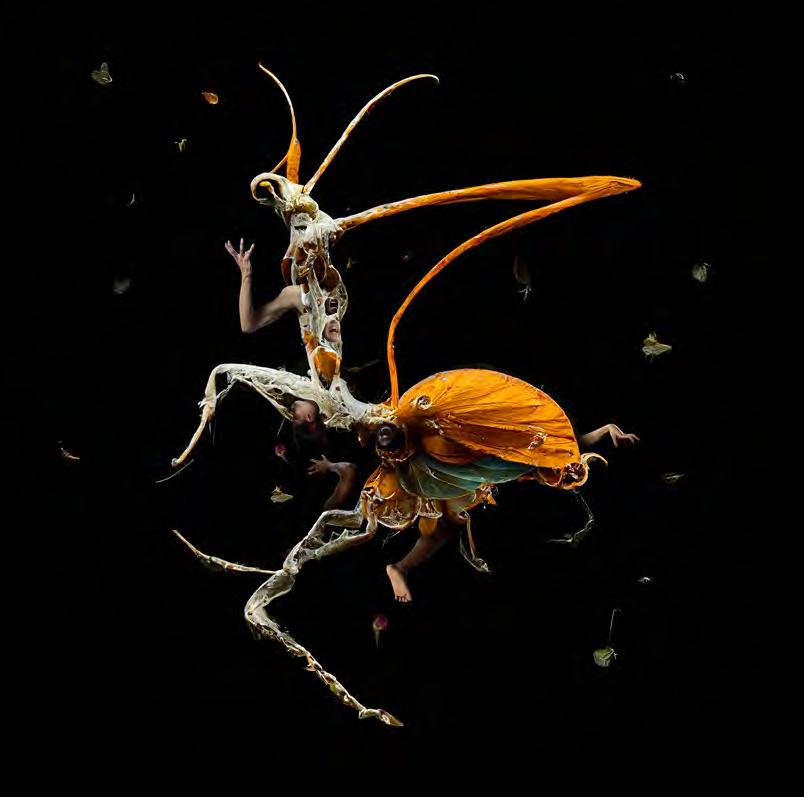
A Frantic Assembly Production, Co-Produced with Theatre Royal Plymouth, Curve, Mast Mayflower Studios and Lyric Hammersmith Theatre

A Comprehensive Guide for students (aged 14+), teachers & arts educationalists
Written by Scott Graham with contributions from the cast and creative team
KAFKA’S
ADAPTED BY LEMN SISSAY OBE | DIRECTED BY SCOTT GRAHAM
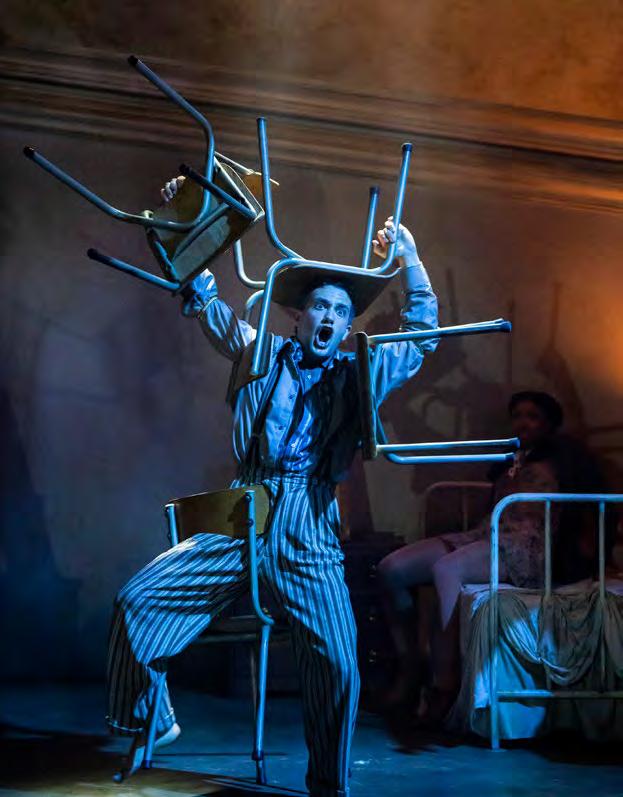
Contents AN INTRODUCTION 3 Why Metamorphosis? 5 Why Lemn Sissay? 6 What about that baggage? 7 Gregor’s Metamorphosis 9 Playing Gregor Samsa by Felipe Pacheco 11 Grete’s Metamorphosis 13 Hannah Sinclair Robinson’s: Grete Samsa 14 So, what is the metamorphosis? 15 The Cruelty of the Lodger 16 The Mirror 17 STRUCTURE OF REHEARSALS 18 Rehearsals 19 REHEARSAL EXCERCISES 21 Day 1 Exercise 22 INTERVIEWS 25 Interviews with the cast 26 Interviews with the creatives 30 POSTSCRIPT 36 Post-script. Literally. 37 BIBLIOGRAPHY 46 The Bibliography of Inspiration 47
Felipe Pacheco. Photo: Tristram Kenton
AN INTRODUCTION

3
Hannah Sinclair Robinson, Felipe Pacheco. Photo: Tristram Kenton
What is this pack
by Scott Graham, Artistic Director
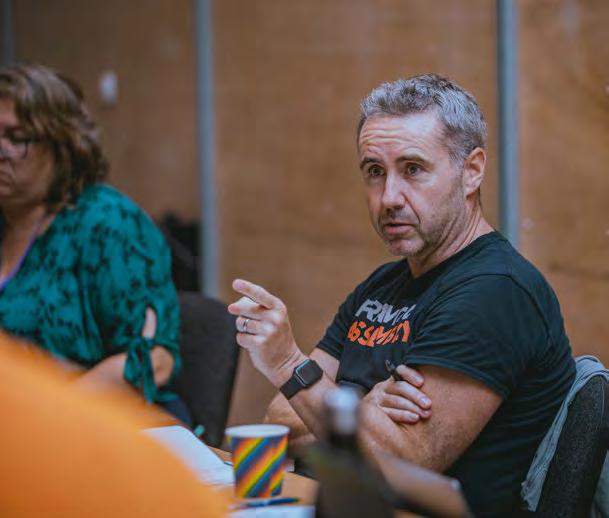
This pack serves to give insight into the creative process behind Metamorphosis. The hope is that insight brings you closer to the work and the ups and downs, triumphs and terrors that always accompany such a process. I would not want a rehearsal process to mystify. Our intention is always to empower and help people feel that they can create. Sometimes that is about highlighting fallibility just as much as inspiration.
Over time there will be more supporting material available through Frantic Digital, our free digital resource. In addition, The Frantic Assembly Studio will host a recording of the full production as well as more detailed study of the themes and processes behind Metamorphosis.
This pack will only address some of the questions you or your students might have. Remember, we are a very open company and will always do our best to answer any questions that might come up that are not addressed within this pack.
4
Scott Graham.
Photo: Adi Detemo
Why Metamorphosis?

That is a good question. It is a title that comes with tonnes of baggage, whether that is an opinion based on a scant reading of the novella (a short novel) or a cherished memory of previous iconic theatre adaptations. In fact, when we announced we were working on an adaptation of Metamorphosis many people commented how they loved that play! But this is a new adaptation, we replied! It has not been written yet! That is the scale of the problem of Metamorphosis and those expectations that surround it.
Those expectations initially put me off the idea of tackling a title like this but when Fraser Ayres suggested Metamorphosis, he was clearly talking about something that felt contemporary and alive. It felt personal to him as he told me about his experience of being defined by the observer. As a mixed race man, he spoke about being defined as too black for some rooms and too white for others. This felt like a brilliant way into Gregor Samsa’s life.
Fraser and I talked about what this Metamorphosis could be, and it was always the word perception that kept recurring. A change brought about because of others perception of you.
Our collaboration did not continue but the idea of a fresh take on Kafka’s novella still burned within me. I could not have the same personal connection to it as Fraser as we could never share that same perspective, but I returned to it convinced that, with the right collaborator, I could find a way to connect to the story and present something new.
5
Perou and Paul Reardon (from Peter & Paul)
Why Lemn Sissay?
You might think it would be easy to find a collaborator wanting to work on an adaptation of Metamorphosis. It wasn’t. Maybe it was the baggage. The task and risk can be daunting. And most of the high quality, experienced writers suggested to me were already tied up with commissions. I was a little uninspired by this approach, anyway. A writer dripping in experience may well be a safe pair of hands, but I sensed I did not want the safety net. I also felt I wanted someone I could work WITH and not merely respond to their adaptation. I wanted someone who felt passionately about the potential of this project but was also open enough to ask, ‘how the hell are we going to do this?’
I had a moment of inspiration and suggested we approach Lemn Sissay. Lemn is a brilliant poet and not known for his theatre adaptations, but I found the potential of his lyricism so exciting. I found I wasn’t interested in someone who could do this with their eyes closed. I was intrigued by what Lemn could bring and the more we talked about it the more I was sure it was the right call and what I needed was Lemn, the person, the poet, all of it.
Lemn is a wonderfully generous presence in the room. A gifted wordsmith, he is also humble and honest. He has lived a fascinating and complicated life that has been well documented. That makes his story one that people THINK they know. Just like Gregor Samsa.
Lemn brought himself to this project just as I did. Our chats and histories have informed our response to Kafka’s beautifully troubling novella. I hope that what we have created is not like a Metamorphosis you have seen before, but it is a genuine response to that brilliant work that shocks, appals and breaks the heart.

6
Lemn Sissay. Photo: Adi Detemo
What about that baggage?
Ah yes, the baggage.
It occurred to me that nearly everyone knew how Metamorphosis opens. It is about that guy who wakes up as an insect, right? That troubled me for a couple of reasons. Firstly, that is about all most people know about it but secondly that will be the moment they are all waiting for, expecting it to happen. That was theatrically problematic. What would Gregor look like? Would Gregor look as you expected and was this based on a previous version stage version? Even Kafka saw this as a problem and insisted that the cover artwork for his book did not depict an insect, or vermin. He suggested an open door. This is much more interesting as it suggests the novella is about how two rooms are joined and the relationships on either side rather than merely an inexplicable transformation.
That transformation is into ‘a monstrous vermin’ but most people expect a more literal insect. Vermin is much more powerful because of its destructive, parasitical connotations, especially when the term is applied to a human. But the image of the insect persists. I have been asked more than once if Gregor will become a beetle, but I insist that it is our perception of him that should define him and not some dodgy costume or a literal presentation. I see his metamorphosis as one from breadwinner to burden, one that radically changes the perception people hold of him and their relationship to him. But more on that later.
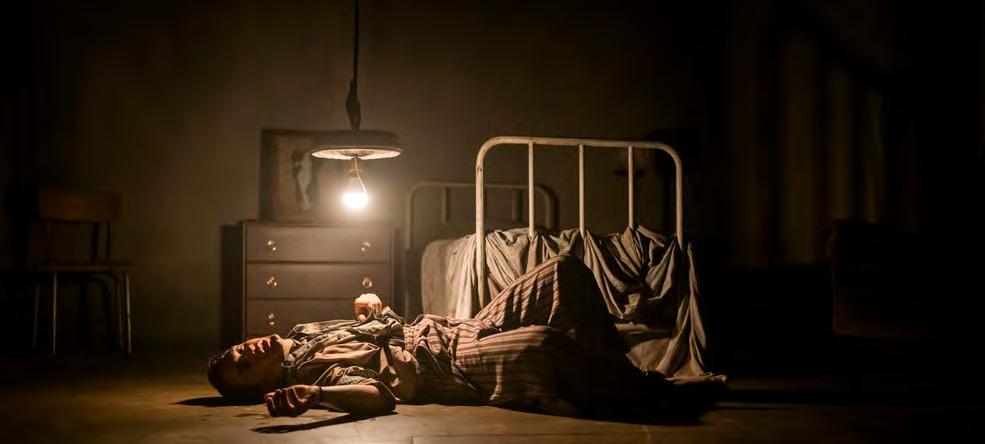
7
I see his metamorphosis as one from breadwinner to burden, one that radically changes the perception people hold of him and their relationship to him
Felipe Pacheco. Photo: Tristram Kenton
Previous adaptations have come and gone but a few have burned themselves into the memory to the point where they have become part of the expectation around any new production or adaptation. As well as people saying that they love that play when I mentioned we were adapting Metamorphosis people have also said that they are looking forward to seeing what I do with all that scaffolding. They are referencing the set design for the Berkoff adaptation! That is the legacy of that production. That is part of the baggage that surrounds this title.
It is rightly remembered as it was a great production. As was Versterport’s adaptation, presented at the Lyric Hammersmith in 2006.
vesturport.com/theater/metamorphosis-hamskiptin/
I saw that production and thought it was a stunning achievement. I could have been scared off a new adaptation by my love for this production alone but decided to take inspiration from these theatrical highs, to aim equally high but to do it in a way that was respectfully different.
There are a couple of moments in the show that nod towards those productions. Just fleeting images but they are conscious acknowledgements of those productions and their enduring legacy.
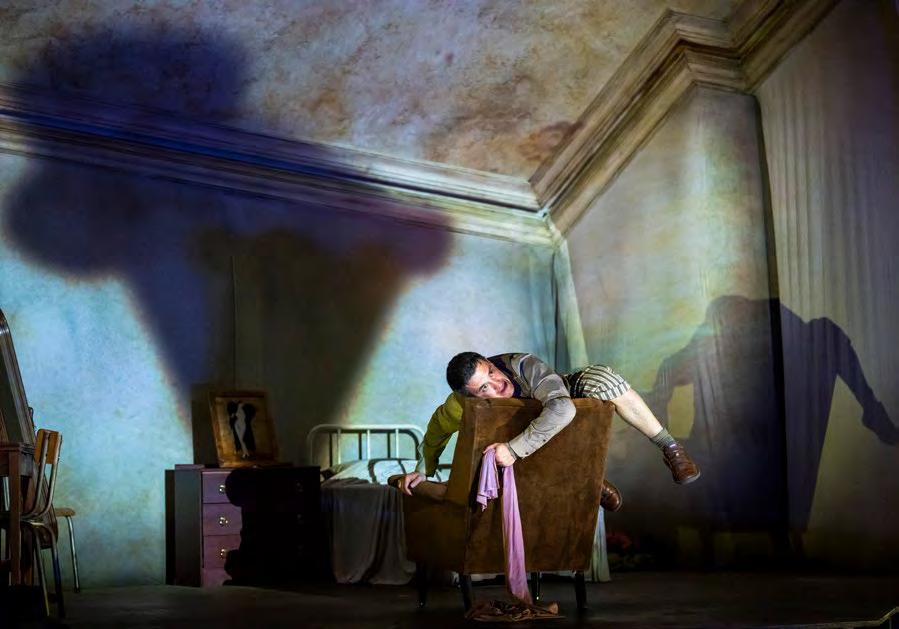
8
Felipe Pacheco. Photo: Tristram Kenton
Gregor’s Metamorphosis
Iwas adamant my production was not going to open with Gregor waking up one morning as a giant insect or ‘a monstrous vermin.’ I did not want to present the transformation as inexplicable but rather as a long process that was allowed to develop unchecked. I wanted to explore the weight of expectation and the corrosive effect it has upon Gregor. It is a physical and emotional breakdown that transforms him from breadwinner to burden. This becomes the catalyst for change in others too. In Grete she becomes his carer, and eventually his judge. She essentially grows up and is seen differently by her parents. Mr and Mrs Samsa’s transformation is more fleeting as we are left with the sense that they return to their parasitic ways, having identified Grete as their new host.
Gregor is in physical and emotional pain. He is exhausted and wracked with guilt and confusion. Much of this is made worse by the extreme efforts of trying to appear ok to those that need him to be ok.
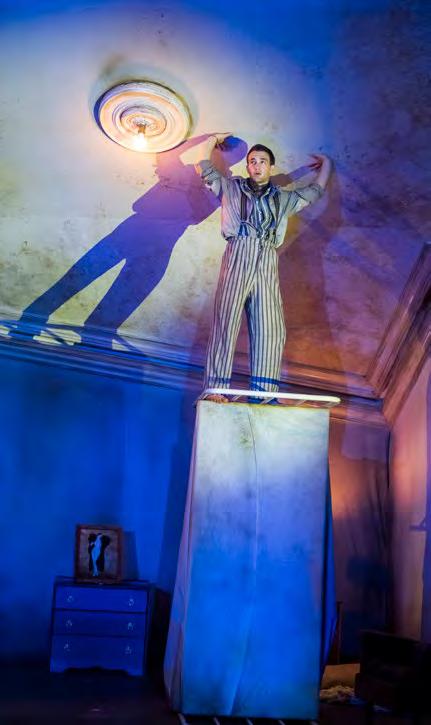
But something has fundamentally changed. As much as he tries, he cannot hide his weakness or trauma from the family or the Chief Clerk. They get it straight away. He is now something less than valuable. Less than human even. He has no value to them.
Gregor might pretend to himself that he is ok, but he knows deep down that he is unwell. I wanted to explore the turmoil created by that tension. It becomes incredibly hard to hit the shapes in the mirror that were designed to convince the world that everything was ok – the straight-backed salesman offering the reassuring handshake, the proud son returning home from a successful day at work. Only one thing could lift him from the floor without effort and that is Grete’s violin playing. Not because it is beautiful, although it is in his ears, but because of what it represents. It is expression, art, freedom, love, everything that his existence is not. His sister’s playing gives him strength just as her humiliation at the end gives him the strength to strike back at the lodger.
9
Felipe Pacheco. Photo: Tristram Kenton
I did not want Gregor’s physicality to be insectlike, but it needed to be physically monstrous. It is not just about his turmoil but also perception. The idea of a Gregor who could not provide for the family would be horrific for them. An image of someone who would now need their care would be even worse. They cannot contemplate his pain and failure. This cannot happen again.
Remember that Mr Samsa has struggled and got into debt. Was that a similar breakdown that has been conveniently brushed under the carpet? There is a moment where Mr Samsa is drunk and falls to the floor and cannot get up. He thrashes around in a similar pattern to Gregor. I was very keen to suggest that there is a family history of strain, pressure and then breakdown that has been buried. Maybe part of Mr Samsa’s cruelty is that he recognises Gregor’s position all too clearly but cannot engage as to do so would reopen his own wounds. It is cruel and unappealing, but I think it is a recognisably human response. Maybe we are all insects being crushed by an economic system that cannot allow for our frailties.
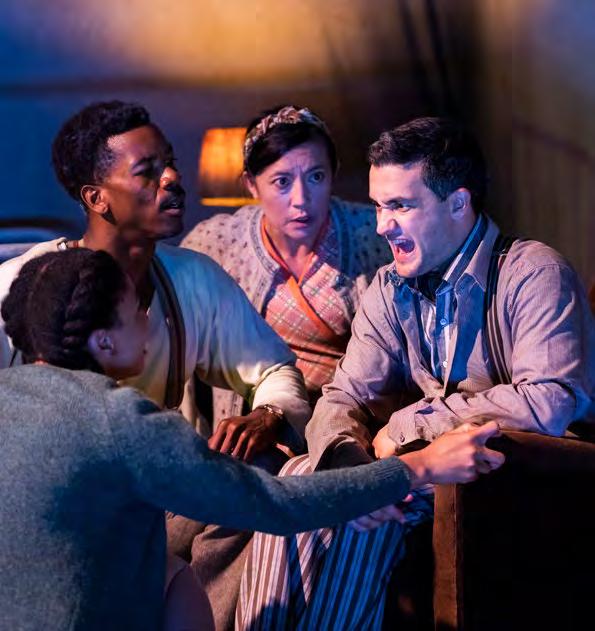
10
Hannah Sinclair Robinson, Troy Glasgow, Louise Mai Newberry, Felipe Pacheco. Photo: Tristram Kenton
Playing Gregor Samsa by Felipe Pacheco
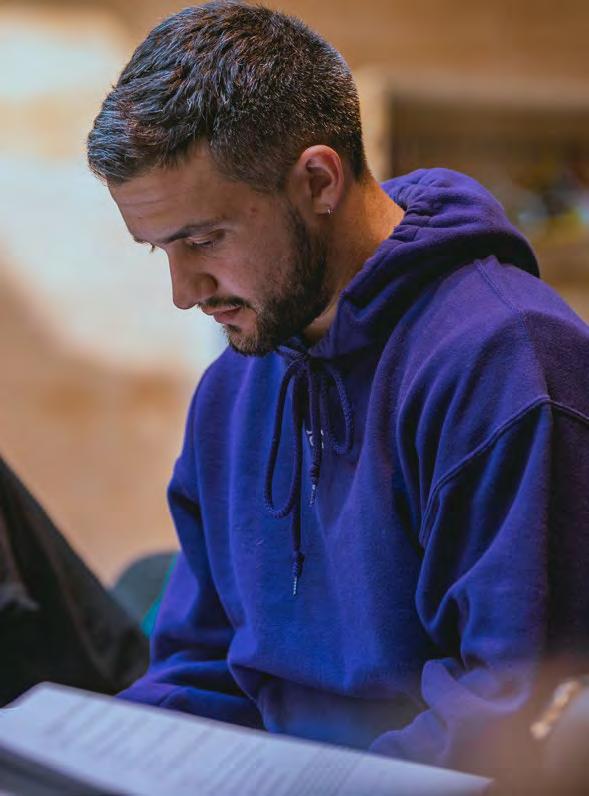
Gregor is a hard-working, aspirational young man. He is devoted to his family and sexually repressed. We can make these assumptions from Kafka’s original text, which has been a privilege to turn to and justify and flesh out ideas on character. In our version however, Gregor doesn’t suddenly wake up, transformed into a beetle/cockroach. We get valuable glimpses of his life pre-metamorphosis, and find out, crucially, that he is adopted. These deviations from the original mean that there are important decisions to be made as a team that affect my initial assumptions. It also leaves space to
make exciting choices. For example, a lot of what we have explored centres around the societal and financial expectations placed on Gregor - how they create a strain on a person illequipped to handle it. The way I see it, he operates on a knife-edge that sits between these expectations, and every day, must muster the will to get up, put on a brave face and walk that tightrope again. This is terrifying, considering the bottom of that chasm looks a long way down. When he gets to work, the office is an equally as pressurised environment, but taking a break, changing jobs or asking for help, might put his family (the people
that saved him, gave him everything) in financial ruin. Their debt and the interest on it can consume them and the house at a moment’s notice, and Gregor has been solely charged with avoiding this catastrophe. It is the repetition and oppression of this daily grind that leads to his eventual decline and, of course, metamorphosis. In addition, as Scott put it in one of his script notes, Gregor ‘longs for an unknown sustenance’ in his repetitive life. Those two things acting at the same time (the oppression caused by societal and financial pressures, plus a longing for something untenable) can only be a recipe for disaster for Gregor.
Felipe Pacheco. Photo: Adi Detemo
In terms of physicality, we also spoke about how ‘bug-like’ Gregor should be and eventually landed on the idea that we needed to satisfy the demands of the novella - give him moments of explicit vermin/insect-like qualities - but also interweave such moments with a man who is simply trying to stay upright, keep the smile on his face. After all, the most valuable thing Gregor sells is the lie that he is okay. I guess you could say we have one foot in the insect world, and one foot out. The set helps us achieve this with its hidden features, as does Lemn’s poetry and Stefan’s music. That’s one of the coolest bits about working with Frantic and I am reminded of it often: it’s not just the big physical sequences we rely on to tell the story - the movement, music, text and design all work together to paint the clearest picture possible in any given moment.
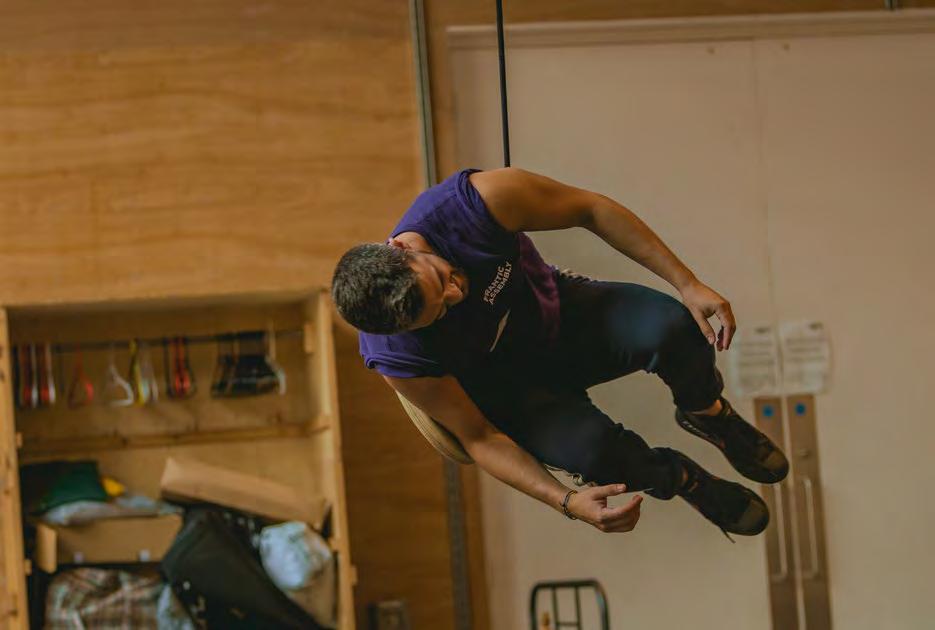
12
. . . it’s not just the big physical sequences we rely on to tell the storythe movement, music, text and design all work together to paint the clearest picture possible in any given moment.
Felipe Pacheco.
Photo: Adi Detemo
Grete’s Metamorphosis
The first person we see trying to get out of bed is not Gregor but Grete. She has a fascination for her brother and sneaks into his room when he has left for work. One of the first things she does is look at herself in the mirror and consider how her body might change, who might she become. The first suggestion of any metamorphosis comes from her.
And she does change through the course of the narrative. We meet her as a slightly precocious and infantilised girl, but she is much deeper and complex than that. Her relationship with Gregor is warm and nurturing. He offers tales of a life on the road, of the outside, of an adult life she has not yet experienced.
Gregor sees her potential to be something. To change, to develop. The family home seems to hold her in a childlike state, but she craves more than this. She is developing into a woman.

We have joked about the show being Gretemorphis as her development is integral. She is a girl on the cusp of being a woman, held back from the outside world. She takes on responsibility and a crushing workload once Gregor is incapacitated. It ages and demoralises her as it has done to Gregor. Once the memory of Gregor has been wiped, her parents finally see how much she has changed and look at her as a young woman. There is a suggestion that this may not be a positive thing as she may well just be another way of bringing some money into the house.
MRS SAMSA Grete is bursting with life. She is blossoming into a beautiful young woman. Look at her. Look at her.
MR SAMSA This is true.
MRS SAMSA Not long now. Soon it will be time to find a good man for her.
13
Hannah Sinclair Robinson. Photo: Adi Detemo
Playing Grete Samsa by Hannah Sinclair
Robinson
My first impressions of Grete were that she was a mischievous girl, who was intentionally subversive and goes on to betray her brother in a horrific act of cruelty. However, as rehearsals went on, I found this was a misjudgement.
Throughout the rehearsal process I discovered that Grete is a young, kind girl that absolutely loves her brother, they are close. She is also at an age where she is discovering her sexuality, but her parents will not engage with her in a meaningful way about how she is developing at this time in her life. She is sheltered and infantilised by her family, giving her a false sense of security in this capitalist society, that sees working class people as disposable. She must figure things out alone, meaning she doesn’t always make the best decisions and she soon realises it is all about survival of the fittest.
In our Metamorphosis, the construct of family is put to the test and with that come big complex emotions that the family must grapple with. During rehearsals I found that where I had initially thought Grete to be intentionally cruel or contrary that is not the case. She is trying to negotiate her form of currency in this world. There is kind, pure intention there, aspiration and ambition within her, there’s a power struggle, there’s confusion, love, misplaced affection but there’s also the need to survive. And as humans when you’ve got all that flying around, we don’t always get it right. Grete has her own metamorphosis through this play, and the challenge I had in rehearsals was not to judge her for it.
To explore my character physically, I created a playlist of classical music that I thought Grete would have been exposed to, would’ve liked or music that stirred me as an actor and made me feel a
Allowing actors to be open and vulnerable when delving into exposing aspects of our characters but also creating the big physical pieces that Frantic is known for.
part of her world (mostly violin concertos or composers from her country and of the time period in which the play is set). I then went onto moving around the space to the music and finding which part of her body, she moves from. As an adolescent on the cusp of becoming a woman, I played with leading from her head, nose and heart. I also played with her physicality when sharing the space with the other actors. She moves very differently when alone with Gregor to when she’s around her Mum and Dad.
A rehearsal room with Frantic is always really hardworking (the morning circuits and conditioning exercises are no joke) but also fun at the same time. It’s a truly collaborative experience, where you are encouraged to engage and make an offer to the work. The whole cast and creative team are in the rehearsal room a lot of the time, which offers a range of perspectives from eyes outside the work and is really helpful when working through big physical sequences or text work.
Frantic’s Metamorphosis studies some very complicated and nuanced relationships and as an actor it can be quite daunting to explore that in a room full of people. Frantic create a safe environment and close community that most importantly you can trust. Allowing actors to be open and vulnerable when delving into exposing aspects of our characters but also creating the big physical pieces that Frantic is known for. Trust and safety are right there at the centre.
14
So, what is the metamorphosis?
However it manifests, physically or theatrically, I think it is most important to think of it as being the transition from breadwinner to burden and what that does to everyone’s perception of their roles within the family or wider society. It changes relationships and alters self-esteem.
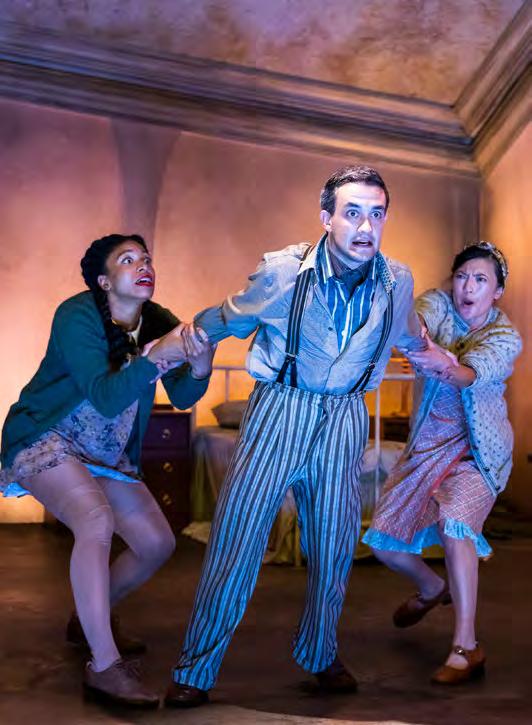
Gregor exists in a world of expectations and responsibility. It is about conforming and delivering. When he finds he cannot do either his value to everyone else plummets. It is incredibly brutal. His role is to provide and pay off the debt. He now finds he is not providing and is contributing to the debt.
You could look at the metamorphosis as illness, disability, or breakdown. You can see how it can affect those around it as well as Gregor. You might understand the levels that people will go to bury the signs of what might be perceived as weakness or failure. I was keen to consider the build up to that change and not see the metamorphosis as a sudden, inexplicable thing. When people are living under such pressure they might mask their struggles, burying them to maintain the appearance that all is well. I wanted to see the metamorphosis as a collapse that Gregor has been fighting, denying for a long time.
15
Hannah Sinclair Robinson, Felipe Pacheco, Louise Mai Newberry. Photo: Tristram Kenton
The Cruelty of the Lodger
The family open their house to a lodger (three lodgers in the novella) as a way of bringing income to the family. It makes them subservient to the lodger. It is a financial transaction that changes the dynamic and status.
I wanted to show how debt can be an inescapable vice and the effect that can have on families. Within our production it might seem like the hardship is having to tolerate a crashing bore at your dinner table, serving him coffee while having to laugh at his awful jokes, but there is a greater cruelty and humiliation here too.
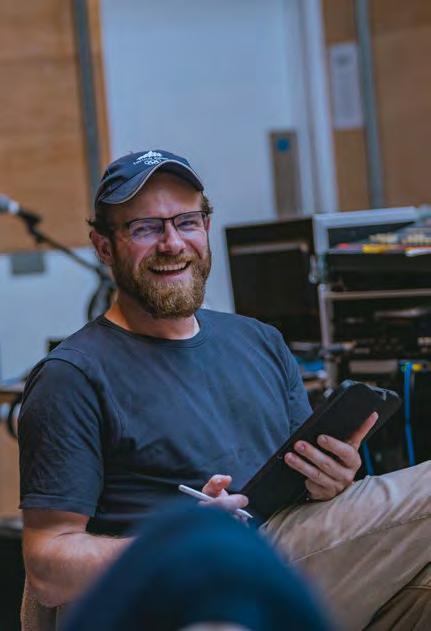
When Grete is invited to play violin, it is clear that she is no virtuoso, but the lodger gets her to play again and again and finds it more and more amusing. At face value it is horrific, but I think there is another level of violence here. I think it is the idea of this girl, the daughter of the people that are serving the lodger, having the aspiration of being a violinist that the lodger finds ridiculous. This is a huge social statement. People like you do not play the violin. You should focus on scrubbing people’s steps.
We can see this in communities across the UK where the Arts and opportunities to engage are being squeezed, devalued, and denied. State schools are pulling back on arts provision while public schools invest in state-of-the-art facilities. Surely this suggest that it is not the Arts that are not valued but the people who might engage and express within them?
I wanted this to be the straw that broke the camel’s back. The event that brings Gregor out of his room, fighting back. It would even galvanise the family for a fleeting moment.
Despite the loss of the financial security, reclaiming dignity is worth the price.
16
Joe Layton. Photo: Adi Detemo
The Mirror
We have spoken about the importance of the mirror in our production. The first thing that Grete does when she gets out of Gregor’s bed is contemplate herself in the mirror. Gregor too poses in front of the mirror as part of his morning ritual.
This is not narcissism. This is part of many genuine questions. Who am I? Who will I be? Do I look like I am supposed to? Do I look like I can get away with this?
The façade or mask is constructed in front of the mirror. Gregor returns to it so often as he begins to crumble. The task of hiding his pain becomes harder and harder. The effort of doing so contributes to the stress.
There is a fleeting moment in the section where Gregor finds himself telling a big lie to his family about a big deal that he is about to clinch. In the excitement of the story telling, he finds himself in front of the mirror and must run away from it. His family might believe his lies, but will he see it in his own face?
The production has lots of masking. Everyone is hiding something by pretending to be what the others expect of them.
There are very few moments of shared honesty, the most extreme of these proving the most troubling. Gregor and Grete share an intense affection and fascination that does not conform to what is expected of brother and sister. Gregor has been adopted by the family and this might cause some of the confusion of
hormones but when Grete kisses Gregor and then Gregor ultimately returns that kiss, it seals his fate and defines him as monstrous. The only way to survive is to adjust the mask and conform and so Grete rejects him,
‘I can’t call this monster a brother’.
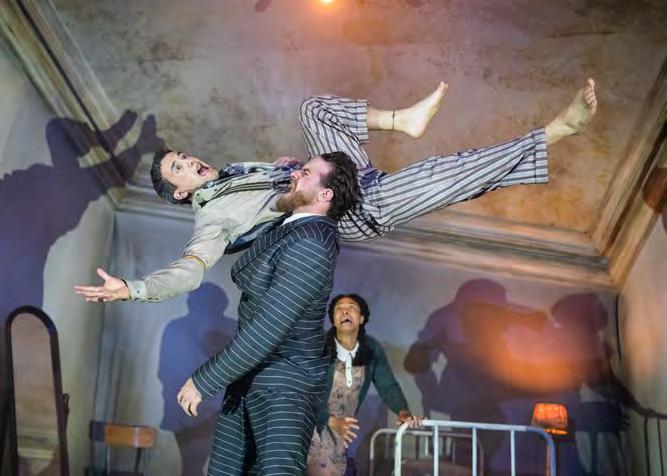
17
Felipe Pacheco, Joe Layton, Hannah Sinclair Robinson. Photo: Tristram Kento
STRUCTURE OF REHEARSALS

18
Felipe Pacheco. Photo: Tristram Kenton
Rehearsals
We have had four weeks rehearsal for this production. The first week was focused on developing and exploring the script. Week two was about creating Act 1 and week three was about creating Act 2. Week four was about having another pass at what we had made and then running it. Generally, we were working on choreography and physicality in the mornings and scene work in the afternoon/evenings.
Miraculously we managed to stick to this schedule.
It meant working very quickly. It meant there was not a lot of time for in depth discussions about minor details. When you factor in that we had to build physical skills, trust, and confidence, the achievement becomes even more startling.
Such a short rehearsal period for a new show is not an ideal situation but there is a perverse thrill to it. It only has a chance of succeeding if you are working with a team that is committed and generous. Luckily this team had both qualities in abundance.
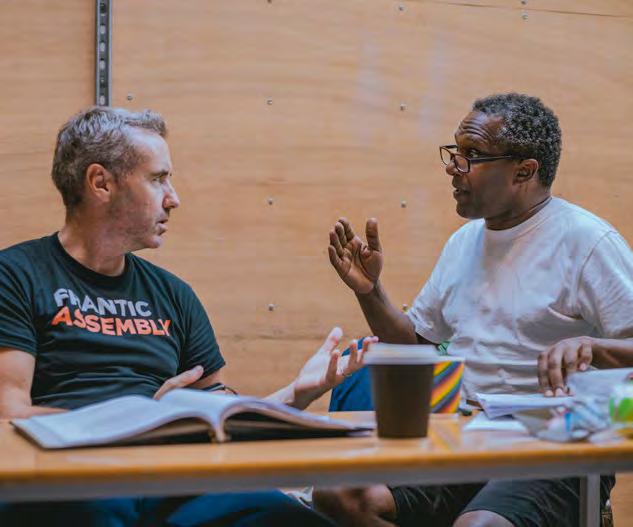
19
Scott Graham, Lemn Sissay. Photo: Adi Detemo
Starting the day
Each day would begin with a game that we developed, initially thinking it was our invention and then finding it similar to Spikeball. Anyone who has been in a Frantic Assembly rehearsal room will know the importance of the games. They are different for each production but are always intense, sweaty, and sometimes, a little competitive! The game has an important part to play in the day. It is a fun and energetic way to begin. It is not connected to the emotional intensity of the production’s subject matter so it can be a good way of starting each day fresh. It is a good way of reminding people that the room and process can be fun as well as serious. It helps connect and build a wider team as anyone in the room, stage management, producers, or visitors, are welcome to join in.
Warm up
After the game is the warm-up. This is where those that don’t have to be there, tend to scuttle off but they are very welcome to stay and join in. We created a circuit training routine of eight stations, each focusing on a different part of the body. The exercises change over the days but the focus on the muscle groups remain consistent. As we progress, we repeat the session, going around the circuit twice. Then the time we spend in each section increases. This is, of course, to build the fitness and strength needed for the physical aspect of the production but it is also integral to building company spirit and that supportive environment needed for people to survive a long tour. Setting manageable targets, meeting them, and then raising those targets creates a sense of achievement that is palpable in the room. We can feel we are getting fitter. We start the day with a spring in our step.
It is the same principle behind the creative process. The Frantic Method breaks every task down into its simplest form and moves forward based on those little successes. It means a process and a room that is building on positivity. The results, just like the warmups, means we are finding we are achieving things we did not think we were previously capable of.
20
The Frantic Method breaks every task down into its simplest form and moves forward based on those little successes.
REHEARSAL EXCERCISES

21
Louise Mai Newberry, Hannah Sinclair Robinson, Felipe Pacheco, Joe Layton. Photo: Tristram Kenton
Day 1 Exercise
I always like to start day 1 on our feet. Many people opt to have a script reading for all those surrounding the production to fall asleep to, but I don’t feel it is fair to have the actors present work on that first day. You can try telling actors that it doesn’t matter but they cannot help but feel the pressure. I prefer to make that first read through private (even though I have a very open rehearsal room with lots of people popping in to observe).
Getting people on their feet straight away helps break the ice but it is also invaluable training. We are moving and having fun. I am observing and working out where I need to focus on building skills and confidence.

My Day 1 physical task could simply be initial building blocks, building strength, demonstrating technique, and developing listening skills. Those ‘listening’ skills are not quite as literal as they sound. They are about all forms of communication including eye contact and, vitally, touch. Taking nothing for granted, I always start with that Frantic classic, ‘Push Hands’ as it still serves as the best example of how complex, simple touch can be!
From there I like to get the cast moving each other around, applying the simple techniques and concepts that allow novices and experienced performers to lift, move and work together safely.
I took Day 1 a step further this time, though. I wanted to introduce the performers to think about the importance of repulsion within our production and how physical precision can help tell a story.
22
Felipe Pacheco, Troy Glasgow, Joe Layton, Louise Mai Newberry, David Gilbert. Photo: Adi Detemo
Repulsion
I introduced the cast to a simple technique to help performers achieve unison in their movement. It was something I developed for Othello rehearsal, to help with the creation of a scene called Othello Thugs. This looked at the flow and movement of large groups of people facing off and fighting. The technique behind it instructed the performers how to send and receive physical signals to give the impression rehearsed unison within improvised movement.
BUILDING BLOCK 1
Place a group of say, 6, people in a clump. Have one person slightly in front and have everyone face out and keep that person within their vision. The person in the front is the leader. There is a simple rule to apply here. If you can’t see the group, then you are the leader. Often the position of being unable to see the rest of the group would create a hesitance or anxiety but we want to show that this is a position of strength, and the others will follow you.
Get the leader to move their arm, slowly but randomly, and have the others follow while maintaining their focus out front. Very quickly this looks like unison.
BUILDING BLOCK 2
Now ask the leader to turn their body while moving their arms. An immediate problem occurs. By turning to the side there is now another person who cannot see the rest of the group. Point out that this person is now the leader. The responsibility to lead and to follow has shifted. Once the group realise how fluidly this relationship and responsibility changes, they can make slightly more complex improvisations. The point is always to work together, though. There is no point in setting your fellow performers impossible challenges. It is all about sending and receiving signals.
BUILDING BLOCK 3
Now they have a technique that binds them, we can introduce a bit of a context.
Ask the leader to see something in the room. They watch it move around. It can get close. It can move off into the distance. It might settle on your shoulder before crawling behind your neck and flying off.
This is a much more detailed journey and is now something specific rather than a sense of unison. Each person within the group needs to see it too and that means the group needs to work together to help us, the audience, understand where the ‘thing’ is. It is not about unison anymore but rather how the difference of perspective of each person suggests a precise position for the invisible ‘thing.’
This is not achieved through improvisation alone. The leader needs to let the rest of the group know exactly where they think the ‘thing’ is and the group responds accordingly to help tell the story.
23
BUILDING BLOCK 4
Expand the journey of the ‘thing’ by having others chart a journey for it and teach the others. That way we create a much longer string of material and each in the group gets a chance to lead and follow. You quickly get a complex journey for the ‘thing.’ Allow the leaders to step out and demonstrate where the ‘thing’ is.
We are not replicating what we were doing in Building Blocks 1-2 but are using the communication skill we learned.
BUILDING BLOCK 6
I didn’t stop there. I wanted to explore Repulsion and have the performers to apply the physical learning from the earlier session. How might lifts help us tell this story?
It was important for the performers to not stop and suddenly work out how they might apply a lift they had achieved earlier. It was about how the situation they might find themselves in might create an opportunity for a lift. If they were so horrified by the advance of the ‘thing,’ might they clamber over each other and effectively climb up the walls? Might they lean back to extraordinary angles to avoid it?
BUILDING BLOCK 5
A little more context. Now you get to play with how we feel about the ‘thing.’ Is it beautiful and mesmerising? Does it possess a deadly sting? Is it of another world entirely?
What about the speed of it? Does that change? Does it settle for a moment. Does it move suddenly and split the group?
You can simply suggest words to inform the playing of that choreography. Words like Beautiful; Repulson; Terror; Wasp; Spirit.
They allow the performers to respond and radically change the meaning of the choreography.
All of this is to be achieved by staying connected and in role rather than by suddenly becoming ‘lifter’ and ‘lifted.’
Through these Building Blocks we have pushed the concept of sending and receiving signals to something quite physically ambitious. That ambition can take the physicality to extremes but remember that it is all built on building blocks. If you rush the process or indicate where you ultimately want to get to too soon you can run the risk of demoralising the performers if they don’t get there. Also, stating where you want to get to leads the performers to edit their choices based on what they think you want. This might sound ideal, but it reduces the potential for you to be surprised and inspired by what comes out of improvisation and creative tasks.
24
INTERVIEWS

25
Louise Mai Newberry, Joe Layton. Photo: Tristram Kenton
Interviews with the cast
Joe Layton: The Chief Clerk/ Lodger
The Chief Clerk is direct, bullish, and domineering, representing the exploitative capitalist system the Samsa’s find themselves trapped in. He relishes his power, taunting the family onstage and haunting Gregor in his dreams.

His speech is remarkably poetic, and he revels in the imagery he conjures. He’s condescending and patronising to the family, whom he views as uneducated and ignorant, entirely disposable. What I had to strive for was finding the lightness and playful, catand-mouse dynamic. In terms of his physicality, the suit, cane, hat, and gloves proved highly effective in establishing economy and specificity in his directness.
In developing the character, I wanted to capture a Jeremy Kyleesque element in the sickening, voyeuristic pleasure he derives from invading the family’s home and pitting its members against each other. Additionally, I wanted to depict him as a slightly absurd game show host, revelling in the family’s inability to answer the simplest of questions. He’s a man who thrives on schadenfreude, finding pleasure in others’ misfortune.
In developing the character, I wanted to capture a Jeremy Kyle-esque element in the sickening, voyeuristic pleasure he derives from invading the family’s home and pitting its members against each other.
26
Hannah Sinclair Robinson, Louise Mai Newberry, Joe Layton, Troy Glasgow. Photo: Tristram Kenton
Equally, The Lodger takes great pleasure in the family’s misfortune. He knows that they need him and enjoys the power that comes with it. However, he is much more insidious, a parasite feeding off the family. I wanted to capture a real sense of entitlement. He has never done an honest day’s work in his life.
The Lodger adores the sound of his own voice, which is reflected in his speech patterns and the speed and flexibility of his thoughts. Exploring this aspect was a lot of fun.
He is an opportunist who values money, material possessions, and potential more than people and their homes. He completely disregards the family and takes immense pleasure in the brutality with which he forces Grete to play the violin repeatedly. It’s a violation.
In terms of working with Frantic, I’ve been fortunate to be involved in three productions, each unique in its process but unified by collective trust and work ethic. I’ll never forget watching ‘Stockholm’ when I was 15, and if I could go back and tell my younger self that I would one day be in this position, I wouldn’t have believed it. It’s an absolute privilege and something I reflect on and remind myself of often.

27
Felipe Pacheco, Hannah Sinclair Robinson, Louise Mai Newberry, Joe Layton. Photo: Scott Graham
Louise Mai Newberry: Mrs Samsa

Iam new to working with Frantic, but I have wanted to work with them for my whole career. I am so thrilled to be in the METAMORPHOSIS cast. Once I got the job, I was suddenly very worried about whether I would be fit enough. I reassured myself that even if I wasn’t fit enough yet, I certainly would be by the end of the rehearsal process! The daily warm-ups are definitely the most physical ones I’ve had for any show. Week by week I’ve grown to love the ball games and circuits and miss them on the days we don’t do them. Who knew?! What I’ve been struck by during the whole process is how welcoming everyone has been, how collaborative it is, and how Scott seems to work with the idea of just trying things out. Instead of sitting around talking and arguing about ideas, we just get up and do it. I love how visceral and immediate it all is.
I had read METAMORPHOSIS in the past and seen several theatre productions but had not really remembered Mrs Samsa, so I was curious as to the direction Lemn would take the character. I was sent part of her monologue for the audition but not the whole play, and so out of context it was quite mystifying! I just decided to enjoy the images and language and have fun with it.
I thought it was really telling that the first line of her monologue is “I don’t say much”. These four words became the basis for my character study of Mrs Samsa. She is a typical housewife in that period whose sole reason for living is to serve her husband and children. Or that’s what she would like us to think. Much of this means she has to keep her needs and feelings to herself. As I began to live with her day to day and as the play grew and developed it became clear to me that while she might not say very much aloud, she is thinking and having
lots of opinions, but they are unsaid. As the play develops and the family unit starts to fall apart, we begin to hear more of her voice, she challenges her husband. We get to learn about the family’s history and experiences through her words. Unlike her husband she speaks the truth, but often the truth is hard to hear. Ultimately, the audience know more about Mrs Samsa than anyone in her family ever does.
28
Louise Mai Newberry, Hannah Sinclair Robinson, Felipe Pacheco. Photo: Adi Detemo
Mrs Samsa is a pragmatist who knows that she is restricted by the expectations of her role in society as a wife and mother. Her personality is such that she will do whatever it takes to hold her family together and this too affects her physicality. She is also restricted by her clothing. My costume is very different from the clothes I would wear normally and so it naturally makes me move more awkwardly. We wear underwear from the period, and it was before Lycra was invented so nothing stretches! We also wear stockings with a suspender belt which is fiddly and uncomfortable. What I love in the show is that Mrs Samsa’s movement is very stiff and often hurried as she rushes around the house trying to rally the troops and keep everything going. However, in her monologue we get an insight into her memory and imagination and there we see a very different person. She is much more joyful, poetic, and free both in her language and her physicality. She comes alive in her inner world in a way that she doesn’t get to express in normal life. In many respects this is quite sad, but it is a pragmatic choice she has made. What I love when playing her is that she has secrets, so many secrets.
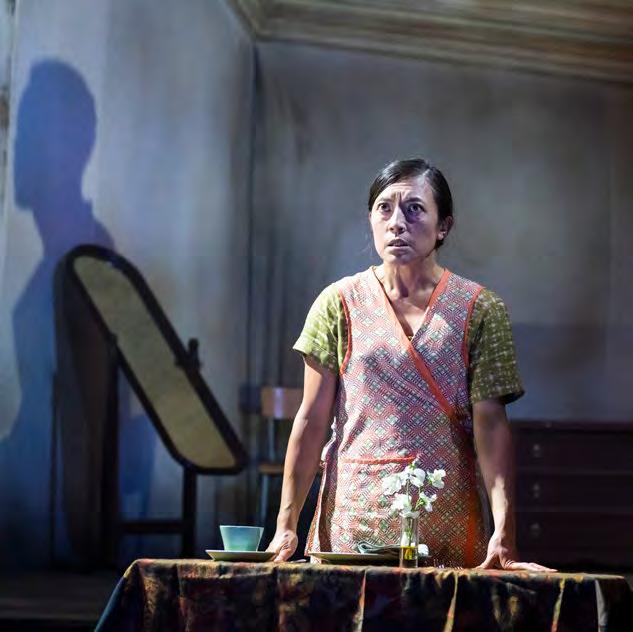
29
What I love when playing her is that she has secrets, so many secrets.
Louise Mai Newberry. Photo: Tristram Kenton
Interviews with the creatives

What is the role of a lighting designer?

The role of the lighting designer is to light the boards for the actors. Lighting the boards meaning lighting the stage to make sure they are seen from every angle and place they could possibly go during the show. With Metamorphosis during the rehearsal period, I would make notes of where I see the actors going. If they are also doing a costume fitting, I will make note of what colours to make sure when I am choosing the colours in the fixtures, I design I choose compatible colours. I also watch the skin tone of the actors and where they are as that also changes what lights you are going to use. During the third week of rehearsals, I would look at a plan so at least when we get into tech week the production electricians will know where to hang all the units, I need to light the stage.
What does a typical day look like for a lighting designer?
A typical day for me on any given show (we tend to be freelancers so we are never working on one show) I will either be in creative meetings for two others shows or design meetings. At this current moment I am working on five different shows! This means you can’t always be in rehearsals all the time as you are split several ways, so you catch when they are doing runs of the show to watch through.
What is your relationship with the cast and creatives on this show?
With the cast it is as this point to just make sure they know who I am, it’s always nice then when in tech you can instruct them and there is not a barrier there for conversation. You are budling that relationship with them, so you don’t always have to go to the director. With lighting and sound designer, you are always fighting for position, where the lighting designer wants to go, sound wants to also go! It’s also good to build a rapport with the sound designer so both of you are in the same head space about where things are going and share that information which is extremely important. Your relationship with the director is a bit more involved, directors don’t necessarily know what they want in the first few weeks of rehearsals because they are building the show so it’s good to be in the rehearsals where if they have a random thought, you then catch those moments and can start building on what they say. It’s good to not just wait for the director to have all the ideas, their job is to have the overarching vision, your job is to be creative which what lights can add to that, so you come with ideas in the direction they are leading the show into.
With the video designer you need to be aware of light intensity and the amount of shadows and light on the set, because video is also a light source.
30
Simisola Majekodunmi: Lighting Designer
What’s been the most challenging thing so far in rehearsals?
Getting round that there is a ceiling in the set, the additional challenge is that this cuts out most of the lighting boards above you, and you can’t put anything on the set ceiling as that is not what is wanted by the set designer. Everything needs to come from the front as you also have walls on three sides! It’s an exciting challenge though.
What has been your highlight so far?
Watching the show being released by the team, usually I don’t always get to see this as I may only be going in on the last week of rehearsals and then tech. Being in the room and seeing the creativity, especially on a show like Metamorphosis and with a company like Frantic Assembly.
What does Metamorphosis mean to you?
This character struggling with the idea of work and the drudgery of the day to day and then metamorphosing into something else. We see how it relates today, if you get yourself stuck into a certain lifestyle you feel pressure to perform which everyone does in all walks of life but then you have to pull back and remember, it wakes you up to the reality of what can happen. Everyone deserves a break; you can’t achieve everything all at once and you must be kind to yourself and not put pressure on yourself to perform for others.
Why did you decide to become a lighting designer?
Well, I thought I was going to be a stage manager! I started my theatre life at school, I never saw a show till I was 16 and I thought ‘I want to do that’ I don’t know what it is, but I want to do it. My drama teacher put me on the stage, and I hated it, so she said go backstage. I got into RADA to study Stage Management and I hated it because I wasn’t that great with people, and you have to be in that role. I went to see Gypsy in the West End and the lighting designer Tim Lutkin had done this amazing thing with light, but I couldn’t work out how and I thought there, that’s what I want to do, I want someone to look at my design one day and wondered how I did that.
31
Interviews with the creatives
What is the role of a composer?


Its someone whose job is to tell a story through music as opposed to words, it depends if you are working for yourself or a director- in either case you will tend to find a story to latch on to be it a film, play or commercial and your job is to tell that story through the use of sound and music. A composer nowadays is expected to do a lot of things, this can be sound design, recording extracts and putting them altogether to tell that story.
What does a typical day look like for you working on Metamorphosis?
A typical day doesn’t really exist! Every day is different, it’s not chaotic in a bad way, but Frantic in a good way. I come in at 9am and finish around 6pm, during the day I have my headphones on and am on hand for the director or anyone else who wants to talk about the music, most of my work is actually done prior to the rehearsal room. I brought a bunch of tracks ready to use in the rehearsal room and since then I have been on hand to edit or add to these. I have also been writing a lot of music live alongside the actors whilst they are devising the piece. A lot of the music you will hear in Metamorphosis was actually created in the rehearsal room.
What has been the most challenging thing for you in rehearsals?
It’s been non-stop which hasn’t been a challenge, but it’s been intense. It’s about multi- tasking. You have to be good at that when you are writing music as well as everything else that goes along with it. Also, it’s always important to keep communication with everyone throughout which is a challenge when everyone is moving at such a fast pace.
What’s been your highlights so far?
The highlight will inevitably be seeing and hearing that first performances when everything comes together- all of the lights, the costume, the sound, the music and actually seeing what the end show is. I have been on this project since April so seeing five months of work come together on that first night will be the highlight.
What does Metamorphosis mean to you?
Change, growing essentially- it’s about growing older, maturing. I had never read the Kafka novella before, when I read it- obviously Kafka is meaning psychological metamorphosis and physical. It’s the changing of someone over time, for me its growing up and going through different phases of life and learning which is maybe what Grete more than Gregor does during this play.
32
Stefan Janik Composer
How did you get into being a composer?
I had always loved music and listened to music; my mum was the biggest influence on me- she would always have music on in the house. I went to piano lessons and then at 12 I got my first set of DJ decks and started DJing, from 12 – 16 I was making house music. From 16 onwards I was lucky enough to be playing in clubs in Ibiza and I was in that underground dance music world. It kind of seemed natural to start making music like that, I started producing electronic music. I also discovered there was a softer more emotive side to music, which through playing piano and producing music I could maybe access and started writing piano pieces, my teacher encouraged me to go and study composition and that was it. I started writing contemporary, classic music and haven’t stopped since!
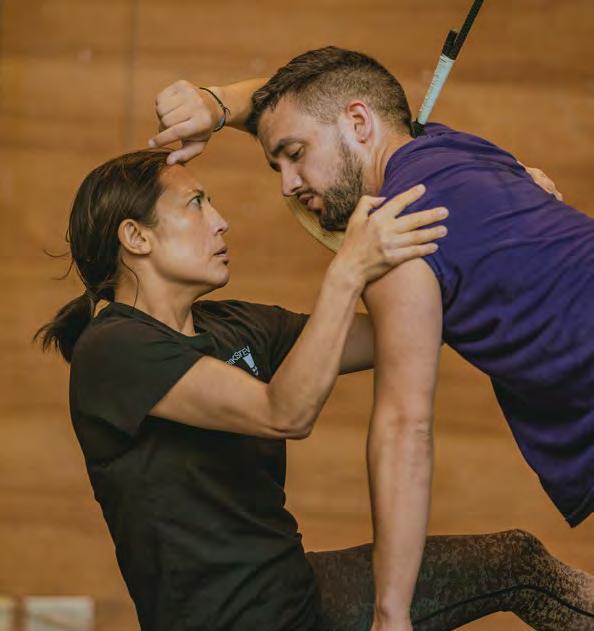
33
Louise Mai Newberry, Felipe Pacheco.
Photo: Adi Detemo
Interviews with the creatives

What is the role of an Associate Director?
What is your relationship with the cast and creatives?
David Gilbert Associate Director

Essentially the right hand to the director in terms of working with the actors and the creatives and kind of overseeing the productions. It’s a role that allows the director to have someone to bounce off creatively and practically in the room. When the show is on tour, I can be the eyes and the ears for the director when they can’t be there, to look after the show from a creative standpoint and making sure the vision of it is still true from what was originally made. This consists of noting the show and checking in with the actors and stage management team.
With the cast it’s about supporting them in becoming more secure about what it is we are creating- is my character making sense, did that line hit in the right way, how do I put my body in that position? I can be the person they can speak to from a creative standpoint, its being an ear or a channel to pass on information, being a bridge between the creatives and the director. It’s about creating a vision and where we are in the vision, with actors it’s about the nuts and bolts. My most intensive relationship is with Scott, the director and making suggestions and giving ideas.
What does a typical day look like?
It’s always specific to each rehearsal room, with Metamorphosis being a new adaption we had a process of two halves where the first initial couple of days were working on the text, analysing it and understanding what it is and how it can take shape- listening and throwing ideas out. We then started to put it on its feet, for me it’s about seeing where I can help, support, where I can guide, where I can be of assistance to creatives who come in at different points. It’s being the glue for the different people in the room. Sometimes it’s being physical and jumping into exercises, demonstrating them- if an actor needs a conversation regarding a piece of text, I might also jump in.
What has been the most challenging thing so far?
As an associate there has not been a major challenge, a creative process is always challenging in terms of being focused and making sure you can bring your best to every single rehearsal. The biggest challenge is that Lemn Sissay (writer) has been very ambitious in his writing and dialogue so the challenge is how we can be authentic in our story telling but also bold and expressive. The biggest challenge is how we rise to the text and come up with the best way to do it justice, but that’s a fun challenge!
34
What’s been your highlight so far?
How the different creatives work together with the type of show we are creating, having the composer in the room, having the sound designer in the room, having the set in the room and the writer. Lemn has created this world for us, and it’s been lovely seeing the making of it, I have just loved how creative and collaborative the process has been. All the creatives coming in and influencing the work, Lemn will come in and say ‘right, I’ve got a new ending!’ You can see all the tweaks and developments of Stefan, the composer changing the sound. I have loved seeing the world unfold creatively and how it’s never finished- you can always keep challenging the work and finding better and distinctive ways of telling your story.
The way the rehearsal room is run, it’s about trial and error and celebrating that, you would never find that if you didn’t push the boundaries.
What does Metamorphosis mean to you?
It’s about transformation, it’s about change, and I guess the thing that’s really fascinating me with the story is the little moments, little decisions that have transformational change. Gregor was obsessed with this part of his life where he had to be perfect, he must be on time to work and can’t be late. The one time he is late it becomes a whole other life, it’s about little changes/ decision in our life that completely transform our reality and I think for me it’s just about how you handle and navigate that moment and shift. For some in this play it leads to dark place and for others it leads to hope. The older I get I realise that whole periods of your life could boil down to a thought or a simple decision.
How did you become an Associate Director?
I started actually performing and was involved in various youth theatres, I also did Frantic Assembly’s Ignition programme when I was 18. I then got different mentors and became interested in directing and started supporting on different projects. I then did the Young Vic Directors programme and then went on to start assisting on shows.
I started by being an assistant director and wanting to learn the craft of directing which then led on to being an Associate Director. I see so much benefit from working alongside a director to really solidify what my practice is and learn and take what I can from being an associate in the room. I like to broaden my reference points and having different references you can pick up from different people and refresh your own process.
I worked with Frantic as a practitioner and through my relationship with Scott I said I wanted to learn how Frantic makes their shows. I remember when I interviewed to become a practitioner for Frantic and I was asked what I wanted to do in the future and I said, ‘I want to direct a Frantic show!”. I am an Ignition graduate of one of the first cohort in 2009, Frantic carved out my experience of what it is to make theatre in this industry. We are in a period of change in this industry and the theatre landscape is changing, I want to be part of the next wave of directors who take our industry to where it needs to go to.
35
POSTSCRIPT
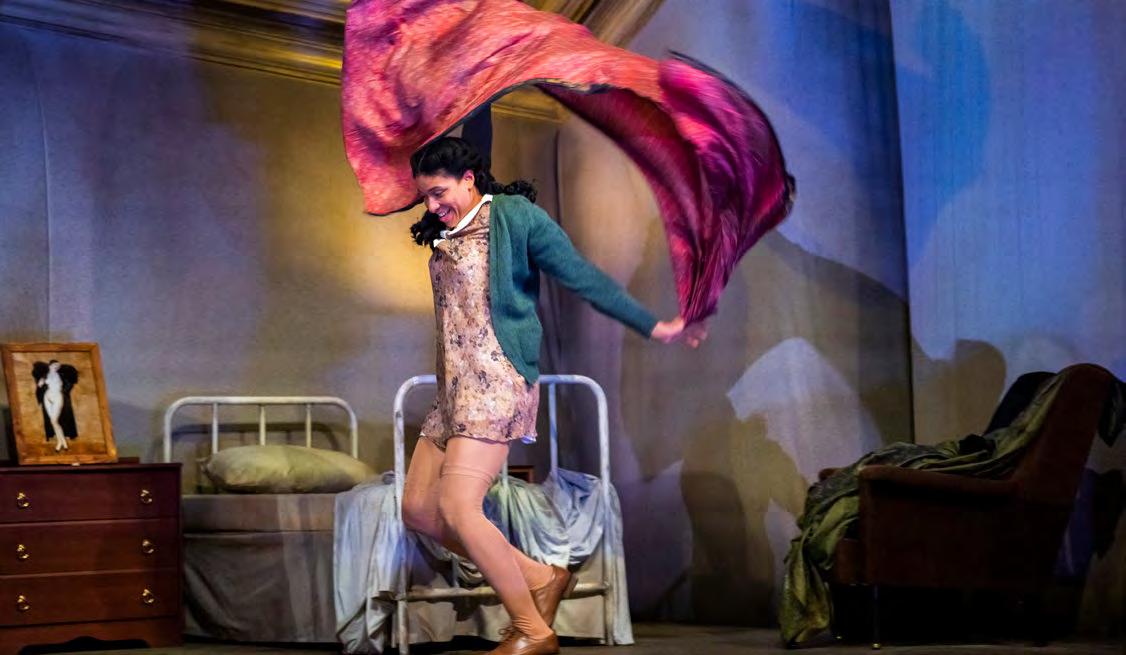
36
Hannah Sinclair Robinson. Photo: Tristram Kenton
Post-script. Literally.

This is a bit of a post-script written from the perspective of having now opened the show! It has met an audience and now it reacts and adapts and finds its rhythm. It is strange to think of all of the hypothetical scenarios we had talked about, all the ways the show could have turned out. It exists now. It has been a long journey.
I decided to look over some notes and my early conversations with Lemn. This was very much written at a time of ‘what if…’ and ‘it could be…’ A time when nothing is set and committing to anything seems a million miles off. Returning to them, I am quite surprised by how many of the moments we talked about found their way into the final production. But that is not always the case and bad ideas can be just as useful as good ideas on that journey. They are equally formative.
Below is an edited selection of some of the thoughts and provocations offered to Lemn at various points.
• Greta has stolen something from her mother. She is in her room looking in the mirror and talking to Valentin. Is it make-up? Or a dress? Or fancy cigarettes? She is young but is trying out an older, more sophisticated Greta. She likes what she sees. Valentin (her name for her violin) likes what he sees. She is called by her parents and the bubble is burst.
• Gregor wakes and prepares to leave the house. Everything is prepared. Everything timed to perfection. He is out the door, and the cold hits him. Somewhere in the drive to push him forward is the quiet question ‘why do I have to do this?’
• Gregor has a new suit and the family fuss and admire. As Greta kisses Gregor’s cheek, she leaves a lipstick mark. It is seen by the family. The mood changes and Greta is sent to her room. (I like the idea of the inappropriateness of Greta’s actions, of wearing the make-up, of the visible stain and what that unearths in the family)
37
Scott Graham, Lemn Sissay. Photo: Tristram Kenton
• There is a tapping at Gregor’s door. This presents several scenarios…
◊ Father wants to speak to him. Does he say what brought him to the door or is it an awkward exchange? Is he just checking to see that no one is in his room?
◊ Greta wants to check on him. She is ‘bored.’ Will he listen to her play the violin?
◊ Mother is at the door. She has nothing to say. It is awkward.
◊ Gregor answers the door, but no one is there. Do we see who has knocked and then walked away? Does he know who it is? Does he know why?
Mother and Greta. Mother wants to teach Greta how to be a woman in the world, but it is a very oldfashioned perspective based on chores and housework. In mother’s eyes Greta can do nothing right. She folds things wrong. She does things in the wrong order. It is a strange interaction that is about women of a certain age gap butting heads. It comes from love, in a way, but it is so destructive.
Gregor wants to talk ask Father about something from the past. Or tell him something about someone who is persona non grata. Gregor persists and Father deflects until a voice is raised and the issue is dropped. Other people in the house have been listening but have not entered the room.
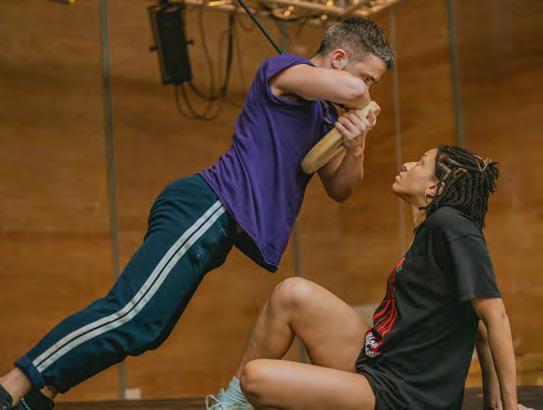
38
Felipe Pacheco, Hannah Sinclair Robinson. Photo: Adi Detemo
Post Metamorphosis
Greta brings Gregor the remains of a pizza in a box. The family don’t normally have takeaways. They are an expense they could do without. But here are the remains of last night’s pizza they had without Gregor. Greta should not be here for so many reasons.
Greta asks Gregor, ‘is it true?’ Gregor is not sure how to answer. She persists. ‘Is it TRUE?’ Gregor is not sure what she means and is not sure what to give away. The question/answer seems to mean so much to her. What does he know that she needs to know? He is not sure she will understand anyway – I like the need from one and the sense of responsibility to answer from the other mixed with the fact that they can only speak different languages anyway.
Gregor lies in bed dreaming or fantasising about what he would say or do to the people who dominate his life. There is a freedom to these dreams. He puts his boss straight. He breaks free of his debt. But the tyranny of his reality means that he will get up on time and catch the usual train.
I like the potential for this fantasy and reality tension. A kind of Groundhog Day of getting up/action/back in bed/getting up/action/back in bed. They can show his paranoia, tension, desires as well as being confusing and conflicting for him. Each could suddenly wake him in a cold sweat.
They could be…
• Something/someone converging on him (this image might not be applicable. Just an early image I liked)
• Greta sneaking into his room and climbing into bed with him. ‘Gregor, open the door, I beg of you’.
• Knocks at his door.
• Voices at his door
• Doors opening when he knew they had been locked.
• The family trying to wake him, him unable to move, and them panicking. Their panic makes them scuttle about, over the walls, into his room, over him and under his bed.
There is something interesting in Greta’s request ‘Gregor, open the door, I beg of you’ – I might be pushing the sexual tension that might exist between our Gregor and Greta, but I keep thinking that it is an action linked to this that makes Gregor monstrous.
When Gregor does emerge from his bed, is he beautiful? Physical potential shackled by the system he is trapped in. He dreams of destroying his bosses and he could! If, at the end, he assaults the lodger, he is released from the shackles. Of course, it is also his demise. By that I mean…
He is a physically strong specimen. He is trapped in a daily routine and working for people who actively keep him down. In his fantasies he uses his strength to crush them. But these fantasies never amount to anything as he returns to the routine each morning because his sense of duty prevails. After the metamorphosis he is considered a beast, vermin. Maybe the attack on the lodger is animalistic. By becoming what the others say you are he is freed of the expectation to conform. He is also destroyed as he DOES become what they say he is. It is this demise that frees him (and destroys him) and frees the family (although it passes on the parasitic focus of the parents from him to Greta)
39
Is he in a coma? I say this as everything that happens after he wakes up is so fanciful and horrific. It reminds me a little of Marabou Stork Nightmares by Irvine Welsh. I don’t really think it is a helpful avenue to go down, though.
I like that he is hyper aware of noise. The noise he makes or tries not to and the noise of others. Footsteps and voices moving around his room.
What is the significance of that photo on the wall? Father even mentions how he made the frame for it. That is the second mention of the frame and the second of the image. Is the woman someone he fantasises about? Does she represent the debt paid off and a new life embarked upon?
Reading it again there is a really startling moment where Gregor realises that Greta has not joined his parents and the Chief Clerk outside his room…

‘And why was she crying? Was it because he had not got up, and had not let the chief clerk in, because he was in danger of losing his job and if that happened his boss would once more pursue their parents with the same demands as before?’
It reads like a Grimm fairy tale! Would the Chief Clerk demand that Greta pays off the debt? How? Even if it was not sinister it would represent the death of her aspirations of a conservatoire education. It means that music and the violin have a huge significance.
The Chief Clerk visits. Gregor comes out and is seen differently for the first time. Do the suspicions of the Clerk change the attitudes of the family? Does he make foul accusations? Does this confirm Gregor’s monstrosity?
Gregor running after the clerk is a wonderfully physical moment. Horrific and pitiful, depending on perspective. Rather than support from his family, Gregor is threatened by his father. Kafka describes a stand-off where they cannot communicate. A huge bust up which results in Gregor returning to his room and the family’s image of him changed forever. In a filmic sense, I see a camera that rotates around the action allowing Gregor to shift from being beast to man and back in an instant. But it is not just him that changes. If our perspective is shifting from the family to him and back, then the image of the family must change too.
40
Felipe Pacheco, Joe Layton, Troy Glasgow, Louise Mai Newberry, David Gilbert. Photo: Adi Detemo
I am picturing a house made of walls on castors that can move and be spun quickly and fluidly, offering us swift changes of perspectives. This allows us to see Gregor as beast and then immediately as misunderstood victim just by taking the action through the frame of the door. It allows us to create rooms, but they can change quickly sending our perspective around the building. None of this is fixed, of course. Just thoughts.
My instinct is that the structure of the novella is key and that we can put meat on this skeleton once we work out that dramatic structure.
This is the structure of the novella…
1. Gregor awakes transformed. Paralysed in bed, the objects that define who he was are laid out around him.
2. Family knock on his door

3. Tries to get out of bed.
4. The Chief Clark arrives and talks to him and the family. There are suspicions and accusations.
5. Gregor struggles to get to the door.
6. Gregor is revealed to the Clerk and the family. Horror and chaos. Clerk escapes. A physical altercation with father. Gregor returns to the room and the door is shut.
41
Louise Mai Newberry. Photo: Adi Detemo
1. Gregor has time to contemplate. He is hurt.
2. Food arrives. It is foul. He looks out to see the family and considers what would happen if he could not continue to provide.
3. Someone is opening the doors to his room and closing them. He has left them open, but no one comes in to his ‘tall, empty room’ (is this what it feels like now? Has it transformed?). He feels sorry for himself.
4. Greta comes into the room. She is disgusted but brings food. (Feeding him pizza? Is this our intensely dangerous sexual tension moment) She leaves the room quickly and locks the door.
5. Greta returns and tidies up. Is this the Greta sent by her parents? The first being the fascinated aroused Greta. This one, the dutiful daughter? Gregor feels some shame.
6. This becomes the pattern. Days of Gregor in his room. Greta entering, providing food and tidying. No contact. He understands her but she does not understand him. Gregor can hear Greta reporting back to the parents. ‘What should they do now?’
7. A bit of history – the family business collapsed –Gregor took the task of financing the family on – He dreams of providing Conservatory education for his sister – something of the family business has remained. Does this mean the family have literally fed off Gregor? They had even been saving a little of his money!
8. What was first perceived as an act of kindness (opening the window) becomes clear it comes from the revulsion Greta feels when she inters his room. Gregor feels deep shame.
9. Mother and father are growing to appreciate Greta. She is developing some usefulness.
10. Gregor spends time walking over the walls and ceiling.
11. The idea of taking the furniture out of the room is a huge potential crisis point. To do so would make his life easier but it would define him as vermin going forward. It would be ‘giving up on him’ and his potential return.
12. Greta’s confidence grows. She makes decisions for Gregor and dominates the family. She is bold enough to be in the room while Gregor runs around the walls and ceilings.
13. The women strip his room. The taking of the picture of the woman in furs is his breaking point (‘He would rather jump at Grete’s face’). He places his body in the way. Greta brings mother into the room and sees him. She tries to get Mother out, but she sees him and collapses. Grete is angry with him. The chaos leaves Gregor OUT of the room and the women IN the room. The hostage has grabbed the gun.
14. The way this gets reported to Father escalates the situation. Father is transformed – employed, upright, strong. A brutal fight ensues.
42
1. Gregor is injured and back in his room. There is a patient truce. He is allowed to sit and watch the family as long as he is unseen. (This feels like a moving camera/an unseen Gregor moving freely but forlornly throughout the house and back to his room). His family are transforming/aging.
2. The family are running out of money and are taking on (demeaning) jobs. (The arrival of the Charwoman. No sure we need her but just charting her story)
3. Mother asks for Gregor’s door to be closed. It feels seismic. It brings Gregor sadness and rage.
4. Food is presented without care. He is being left in his squalor.
5. There is an argument about who has the right to clean Gregor’s room. Grete is possessive (but why?). No one is really thinking about Gregor.
6. Work is taking its toll on the family (and they are not noticing the fasciation and potential sadism of the charwoman). Stuff begins to accumulate in Gregor’s room, and it becomes clear that space is being made for a (three) lodger(s). His room is a dumping ground.
7. Gregor watches as he sees his family become the service for the lodgers. Everything the lodgers do gets under his skin.
8. Grete plays the violin. The lodgers suggest she plays for them. Gregor is enticed by the music. No one notices him approach. The lodgers get bored of the playing and begin to chat. Gregor loves the music. He wants to show her his appreciation. This moment betrays an intense affection for her ‘He never wanted to let her out his room, not while he lived, anyway.’
9. Gregor is spotted by the Lodger (I like the idea of Gregor coming out and walking through the room without being spotted and attacking the lodger) Chaos resulting in the lodger handing in his notice but not before refusing to pay. They leave and the family are left without means.
10. Grete turns on Gregor. ‘I don’t want to call this monster my brother!.. we have to try and get rid of it’ – (was it the violence that turns her? Was it the losing of what they thought might be their only way out of the financial mess? Was it Gregor’s show of love for her that tips things over? There is something about the proximity of ‘monster’ and ‘brother’ that is really interesting. I also see Gregor being brutally beaten by Greta and Father. He is beaten down into something broken, crawling on the floor)
11. ‘If he could just understand us.’ But he does. And he knows he is not wanted. He knows it would be better for them if he were to be gone. When he begins to go the others let him
12. Gregor finds an acceptance – ‘He thought back on his family with emotion and love.’ He dies. (Does he leave?)
13. He is found by the cleaner. The family notice how thin and weak he was. The cleaner shows the corpse to the lodger. The family summon the strength to dismiss the lodger.
14. The cleaner gets rid of the body. The family commit to sacking her. They go for a walk and literally bloom, planning a future and finding a man for Grete. They have noticed how she has blossomed into a strong woman.
43
The picture in a frame. This image is about aspiration. He aspires to be with this woman. It is also about freedom because he is not free to create a relationship of his own while he is responsible for the family debt. There was reference in some notes to his repressed sexual desire and how this might manifest in a desire for Grete, however fleeting. This works for us. If he fantasises about the woman in furs does Grete innocently dress up as her using some of his fabric? Does this make Gregor shout at Grete to take them off?
Anxiety is his shame. It is his secret. It all comes out when the Clerk comes around. The Clerk talks about it and his underperforming. He is not what he has appeared to be to the family.

The transformation is still tricky to land. I believe it has been coming and a big sign is the kiss/lipstick moment. The family are seeing him differently. He is not the boy they brought into their life. He is now a man, and they would never have allowed a man into their house around Grete. They only did so because he was bringing in money. I think the transformation must be real. I also wonder how much his family might have seen of his anxiety or struggles at work.
What is a little tricky is communication. We have some decisions to make. In the novella he can understand them, but they can’t understand him. Do we stay true to this or is it more interesting to have a total breakdown of communication?
The kiss. If he returns a kiss at the end, it is what explicitly makes him a monster. He has just kissed his sister. It allows everyone to dismiss him with impunity.
44
Troy Glasgow: Photo: Adi Detemo
These were thoughts shared between me and Lemn as they came up. It is interesting to see which ideas stayed, which remained unsolved, or which fell from focus. Of course, not all of them can be found in the finished production.
A lot of the writing for the production came about through setting provocations and tasks for Lemn, meaning that he seldom felt the weight or responsibility for the whole show. I instinctively felt that the key to getting the best of Lemn was to give him a freedom to fly. I know the debilitating weight that responsibility can be, so I developed the structure of our production through various research and development sessions and asked Lemn to write for characters and a situation, e.g., Gregor crawling through the house at night or Grete and her violin. Lemn also leapt into monologues for Mr Samsa telling a pompous story of ‘Beggars Can’t Be Choosers’ and the wonderfully convoluted word play of the Chief Clerk’s entrance. I am not sure these lyrical flights would have occurred if weighed down by the question of where they existed in the structure.
Once Lemn offered these beautiful moments it was again my task to consider where they might sit in our structure.
I thoroughly enjoyed our collaboration. It felt like we could build upon each other’s contribution and could make offers without fear of rejection or sounding stupid. Another brilliant writer I worked with (Andrew Bovell) once said to me during our rehearsals for Things I Know to be True, ‘I think I know what collaboration is now. It is never saying ‘No’’
It would be wrong to suggest that this means every suggestion goes into the show but what he meant was every suggestion is embraced and interrogated and, if found to be robust and exciting, makes it in. If not, it gets parked. This means that offering an idea does not become a defensive act. You want that idea to be explored with rigour because you trust the eye and motives of your collaborator. They will always say yes but we all commit to letting go when it does not quite hit what we need.
45
BIBLIOGRAPHY
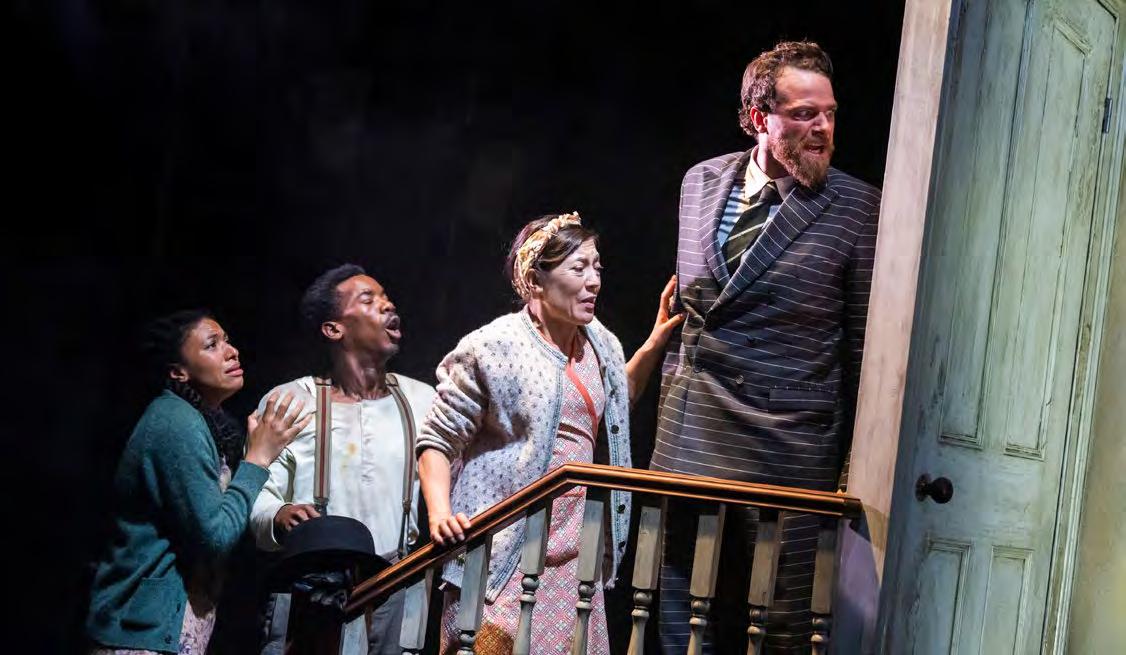
46
Hannah Sinclair Robinson, Troy Glasgow, Louise Mai Newberry, Joe Layton. Photo: Tristram Kenton
The Bibliography of Inspiration
This is a bit of a tradition where I make a list of the references that have helped us move forward and share an understanding about our adaptation and production of Metamorphosis. It can throw up some unexpected links, but I think it is important to be honest about what your inspirational references are and where they come from. They are not always highbrow intellectual and nor should they be if they genuinely help you push things forward.
Aftersun Film Dir. Charlotte Wells youtube.com/watch?v=xAL9kuqc-kk
A lighting effect used in a scene played out in a nightclub. Don’t just watch for this, though. It is an extraordinary film.
‘Switch on!’ a phrase David Gilbert David would say this a lot in our warm-up ball games. It had various incarnations including ‘switchings, please!’ It was an invitation to focus as things got competitive. It became a shorthand within the company for time to apply ourselves to the best of or abilities. It was a gentle and inclusive but very clear way of saying ‘we need to pick things up a bit here.’ It reminded us it was all a team game, and we were all connected and responsible.
Fraser Ayres a conversation and provocation
Fraser originally suggested Frantic Assembly taking on a new adaptation of Metamorphosis. My initial instinct would have been to avoid but Fraser’s focus on perception being what defines the other turned things around. That felt like a new and fresh way in. One that would define this production as different from the iconic adaptations that preceded it.
A short playlist
open.spotify.com/ playlist/4GIq0KcGFHac8ev8QuHbfM?si=7bcad0e4ba5742e7 Played often while thinking and writing. It also became a shorthand for mood and atmosphere between me and composer
Stefan Janik
A bit of genuine research! – The Fantasy of Punishment; Masochism in Franz Kafka’s The Metamorphosis, by Libby Edwards omniummedia.files.wordpress.com/2019/08/4-edwardsmasochism-in-kafka.pdf
Team America: World Police Film dir. Trey Parker Best not to ask!
‘Season Preview’ Event
Many years ago, I attended an evening showcasing much of the work that would appear at a theatre and comedy venue. We were performing later in the season. The evening consisted of various acts either talking about or demonstrating their upcoming work, all hosted by a comedian as an MC.
There was an amateur a capella group singing ‘My Girl’ and one of the singers was painfully flat. People started to find it funny but they remained oblivious. As the evening drew to a close, the comedian MC mentioned the a capella group as his personal highlight and invited them back on stage to sing again. The group were obviously delighted and duly obliged while the crowd sniggered. The singers were never in on the joke.
I found this shockingly cruel and it has always stayed with me. I based the Lodger’s treatment of Grete on this moment.
47
Wuthering Heights Emily Brontë
The discovery and adoption of Gregor and his relationship with Grete is a bit of a nod to this novel. To be honest, it is not really inspired by it. When we were exploring the family history and what it might be I found myself referencing the novel (not the song). I was as surprised as anybody!
The Metamorphosis of Mr Samsa short film Caroline Leaf
youtube.com/watch?v=GHvy-J1BFu8
Metamorphosis short film Anna Rudichenko
youtube.com/watch?v=Yd8sRHhV2Qw
Early design references
Zoetrope
youtube.com/watch?v=-hE_fA9M580
Praxinoscope youtube.com/watch?v=eJqp7Dlq66k
Metamorphosis Thug Notes youtube.com/watch?v=_E9aOuf6eI8
A quite brilliant but sweary synopsis/analysis of the Kafka novella
48


BRIXTON HOUSE, 385 COLDHARBOUR LANE, BRIXTON, LONDON, SW9 8GL +44 (0)20 7841 3115
Troy Glasgow, Louise Mai Newberry. Photo: Tristram Kenton







































